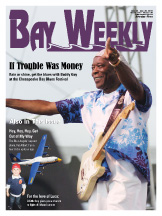Chesapeake Bay's Independent Newspaper ~ Since 1993
1629 Forest Drive, Annapolis, MD 21403 ~ 410-626-9888
Volume xviii, Issue 20 ~ May 20 to May 26, 2010
Home \\ Correspondence \\ from the Editor \\ Submit a Letter \\ Classifieds \\ Contact Us
Best of the Bay \\ Dining Guide \\ Home & Garden Guide \\ Archives \\ Distribution \\ Advertising![]()


Endangered Species Day, International Day for Biological Diversity and World Turtle Day Are Coming
How are you planning on celebrating?
Have you encountered any American bison lately on the Maryland range? Such a sighting would have been more likely had you been around a few hundred years ago. Like gray wolves, wild bison have been pushed out of Maryland. People did the pushing, people who believed this land was made for you and me.
I note this extirpation because this is a big week for rare, threatened and endangered species.
Upcoming are Endangered Species Day, on May 21; International Day for Biological Diversity, on May 22; and World Turtle Day, on May 23.
Such days are needed lest rare, threatened and endangered become steps on a slippery slope to extinction.
Since European colonists made this land their own in the 1600s, more than 500 species and subspecies of native animals and plants have become extinct in North America, reports Maryland Department of Natural Resources. Some of this extinguished life lived here in Chesapeake Country. Passenger pigeons blackened the sky during migration, Carolina parakeets roosted in coastal swamp forests and heath hens boomed on rolling grassland hilltops.
You won’t see their like again on any range. The federal Endangered Species Act of 1973 put the brakes on the rush to extinction.
“The Endangered Species Act is the nation’s premier law protecting biodiversity today,” says U.S. Fish and Wildlife Service Acting Director Rowan Gould. The law is credited with helping prevent the extinction of hundreds of species nationwide.
Many more remain at risk: 1,324 species are listed in the U.S., including 750 plants and 574 animals.
Maryland has its own sizable list of species on the brink. Among the rarest and most in need of conservation, Maryland lists 1,100 species. Of these, DNR officially recognizes 607 species and subspecies as endangered, threatened, in need of conservation or endangered extirpated.
Only 37, or three percent of the total tracked species, are listed by the U.S. Fish and Wildlife Service as nationally endangered or threatened.
So we’ve got fellow Maryland creatures to care for, as well as fellow American creatures. Not to mention all the stressed creatures with whom we share Planet Earth.
Threatened pandas are easier to relate to than some of their wiggly threatened, rare or endangered brethren, like tiger beetles. But we’re likely to be able to do more on behalf of neighboring creatures than ones half a world away.
Hop onto Maryland’s Natural Resources website at www.dnr.state.md.us/wildlife/Plants_Wildlife/espaa.asp, and you can see who’s in danger in your own backyard.
Anne Arundel lists 135 species, including 35 animals and 100 plants. They range from the pied-billed grebe to the American peregrine falcon to the bald eagle. In insects, from the red-legged purse-web spider to the little blue dragonlet. In plants, from fly poison to single-headed pussytoes.
Calvert lists 72, including 16 animals and 56 plants. Here you can add the Atlantic sturgeon among fish; the notorious northeast beach and Puritan tiger beetles among bugs; and American barberry and small-fruited beggar-ticks among plants.
What would you do if endangered tiger beetles threatened your home? Perhaps not the way all-too-flourishing carpenter bees do, but indirectly, by depending for their survival on crumbly erosion that could pull your house into the Bay? That’s an active environmental dilemma for our southern Calvert neighbors.
Most of us know few endangered species by name, looks or habitat. Perhaps we’re lucky that our paths don’t cross.
On the other hand, this week gives us reason to take a closer look.
© COPYRIGHT 2010 by New Bay Enterprises, Inc. All rights reserved.
